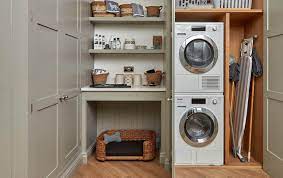Designing an efficient and aesthetically pleasing laundry room is a key consideration for homeowners looking to optimize their living spaces. With advancements in technology, the use of laundry room design tools has become increasingly popular. In this article, we’ll explore the benefits of using a laundry room design tool, how to utilize one effectively, and tips for creating a functional and stylish laundry space.
Advantages of Using a Laundry Room Design Tool:
- Space Optimization: A laundry room design tool allows homeowners to make the most of available space. By inputting room dimensions, placement of appliances, and other structural details, the tool can help optimize the layout for maximum efficiency.
- Visualizing Layouts: Visualization is a key advantage of using design tools. Homeowners can see a realistic representation of their laundry room design before making any physical changes. This helps in making informed decisions about the placement of appliances, storage solutions, and overall layout.
- Appliance Placement: Determining the ideal placement for washing machines, dryers, and other appliances is crucial for a functional laundry room. Design tools enable users to experiment with different configurations, ensuring convenient and ergonomic placement of appliances within the space.
- Storage Solutions: Design tools often include features for experimenting with various storage solutions. Homeowners can explore different cabinet designs, shelving options, and organizational elements to create a well-ordered and clutter-free laundry room.
- Material and Color Selection: Choosing the right materials and colors is essential for achieving a cohesive and visually appealing laundry room. Design tools allow users to experiment with different finishes, countertop materials, flooring options, and color schemes to find the combination that suits their taste and style.
- Budget Planning: Many design tools provide cost estimation features, helping homeowners plan their budgets effectively. This feature allows users to make informed decisions about materials, appliances, and other elements, ensuring that the final design aligns with their financial considerations.
How to Use a Laundry Room Design Tool:
Choose a User-Friendly Tool: Start by selecting a user-friendly and intuitive laundry room design tool. There are various online tools and software applications available, ranging from simple room planners to more sophisticated design platforms. Choose one that aligns with your skill level and design requirements.
Input Room Dimensions:
Begin by inputting the dimensions of your laundry room. Accurate measurements are crucial for creating a realistic representation of the space. Include details such as door and window locations to ensure an accurate layout.
Place Appliances:
Position the washing machine, dryer, and any other appliances within the virtual space. Experiment with different layouts to find the most ergonomic and space-efficient arrangement. Consider factors such as workflow and accessibility when placing appliances.
Experiment with Layouts:
Use the tool to experiment with different layouts. Consider the placement of countertops, cabinets, and storage solutions. Visualize how the laundry room flow will work, ensuring that the design meets both functional and aesthetic requirements.
Explore Storage Options:
Design tools often include a variety of storage options. Experiment with different types of cabinets, shelves, and baskets to find the best storage solutions for your needs. Consider incorporating features like pull-out hampers or built-in ironing boards for added convenience.
Choose Materials and Colors:
Experiment with different materials and colors to achieve the desired look for your laundry room. Explore various flooring options, countertop materials, and finishes for cabinets. Pay attention to how different color schemes can impact the overall atmosphere of the space.
Review and Refine:
Once you have created a preliminary design, take the time to review and refine it. Consider factors such as traffic flow, functionality, and overall aesthetics. Make adjustments as needed to ensure that the final design meets your vision for the laundry room.
Save and Share:
Most design tools allow users to save their designs for future reference. Additionally, consider sharing the design with professionals, such as contractors or interior designers, for expert input. Collaboration can enhance the final outcome and ensure that the design is both practical and stylish.
Tips for Creating a Functional and Stylish Laundry Room:
- Prioritize Workflow: Design the laundry room with a focus on workflow. Ensure that the placement of appliances and storage solutions facilitates a logical and efficient sequence of tasks.
- Incorporate Ample Lighting: Adequate lighting is crucial for a functional laundry room. Incorporate both natural and artificial lighting to create a well-lit and inviting space.
- Invest in Quality Appliances: Choose high-quality, energy-efficient appliances for long-term durability and efficiency. Front-loading washers and dryers are popular choices for their space-saving and water-saving features.
- Consider Multipurpose Spaces: If space allows, consider incorporating a multipurpose area within the laundry room. This could include a folding table, a utility sink, or a dedicated space for pet care activities.
- Choose Durable Materials: Given the high-traffic nature of laundry rooms, opt for durable and easy-to-maintain materials. Consider moisture-resistant flooring, stain-resistant countertops, and washable wall finishes.
- Add Personal Touches: Infuse your personality into the design by adding personal touches. Consider decorative elements, artwork, or a pop of color that reflects your style and makes the laundry room a more enjoyable space.
- Plan for Adequate Storage: Plan for ample storage to keep the laundry room organized. Include cabinets, shelves, and baskets for storing laundry essentials, cleaning supplies, and other items.
- Maximize Vertical Space: Utilize vertical space by installing cabinets and shelves that reach the ceiling. This maximizes storage capacity and helps keep clutter off the floor.
Conclusion:
Using a laundry room design tool is a valuable step in creating a functional, efficient, and stylish laundry space. By exploring different layouts, experimenting with storage options, and visualizing materials and colors, homeowners can design a laundry room that meets their unique needs and preferences. Follow the tips provided to make the most of the design process and create a laundry room that enhances both the practicality and aesthetics of your home.

